Global Access Control & Time Attendance System Market - Comprehensive Data-Driven Market Analysis & Strategic Outlook
The global access control & time attendance system market initially emerged as a response to the growing need for synchronized employee management and safe building access. Early firms relied on manual employee registers and key locks to achieve basic operational control. Although these processes functioned, they were prone to producing inconsistencies and inefficiencies. As companies expanded and work environments became more complex, businesses came to realize the worth of automated systems that were capable of guarding their buildings and accurately recording employee data. This was the beginning of what would be a very sophisticated industry focused on access control and time management technology.
- Global access control & time attendance system market of approximately USD 3906.8 million in 2025 with a CAGR of roughly 10.6% between 2032, and it is going to be even more in value than USD 7911.8 million.
- Card Type with a market share of nearly 25.6%, pioneering research and expanding applications through extensive research.
- Trends with a high growth potential: Increasing demand for increased security and data protection across organizations, Increasing demand for workforce productivity tracking and automation
- Opportunities: Convergence of biometric and AI technologies for advanced authentication and analytics
- Key finding: The market will expand exponentially in value within the next decade, signaling high growth opportunities.
- During the 1980s and 1990s, magnetic stripe identification and electronic card readers were the first actual technological innovations.
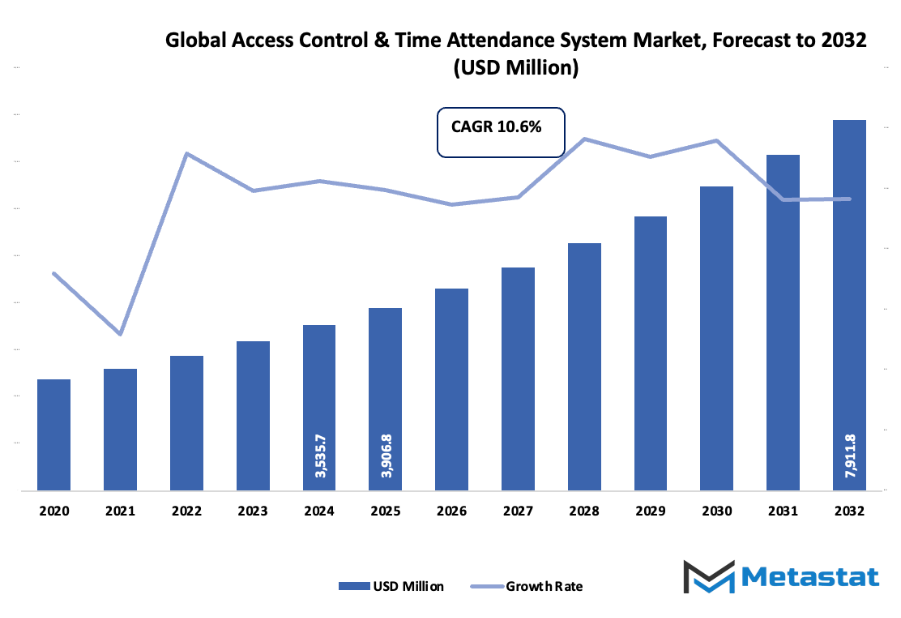
These systems took monitoring the workforce from paper to tracking data. In the early 2000s, biometric solutions began appearing, including fingerprint and facial recognition for validating workers. This technology introduced a new degree of accuracy and reliability, reducing time fraud as well as the requirement for physical credentials. The global access control & time attendance system market gradually integrated these technologies across various industries such as manufacturing, healthcare, education, and government. As globalization gained momentum, organizations required integrated systems to track attendance and access across various locations. Cloud-based solutions began to appear, and real-time monitoring and remote access to information. This change evolved the way companies managed their workforce, turning it into a strategic operations insight tool instead of a back-office process. As regulatory regimes for data privacy and workplace security began to condition system design, vendors were forced to create compliant and open systems. The global access control & time attendance system market will continue to develop in the upcoming years in accordance with digitalization. Predictive monitoring will likely be enhanced by artificial intelligence and analytics, whereas mobile device integration will make access management even more flexible. From paper records to smart connected systems, this market's revolution has followed the larger movement towards smarter, safer, and more efficient workplaces—a trend that continues to develop.
Market Segments
The global access control & time attendance system market is mainly classified based on Type, Application.
By Type is further segmented into:
- Card Type: Card Type systems will continue to be in demand for access control and attendance tracking. They are cost-efficient and convenient, allowing firms to track the movement and attendance of employees with ease. They will be made even more secure and accurate through integration with digital identification and smart cards in the future.
- Password Type: Password Type systems will be a flexible solution to access control. Secure entry management will be made possible without physical devices. Enhanced encryption and multi-factor authentication will increase the reliance of Password Type systems on companies that require environments to be secured for the forthcoming years.
- Biometric Type: Biometric Type systems will dominate due to their security and precision. Fingerprint, facial, and iris scan technology will continue evolving to be even speedier and more precise. Future technologies will render Biometric Type systems indispensable to organizations that have high access control and precise attendance monitoring requirements.
By Application the market is divided into:
- Government Agencies: Government Agencies will use advanced systems to provide more security, monitor attendance, and manage large volumes of employees. Applications of the future will be equipped with real-time analytics and cloud storage, enhancing decision-making and operational efficiency in high-risk administrative and security-focused environments.
- Factory: Factory operation will be boosted by automation and live monitoring with global access control & time attendance system market solutions. The systems will ensure efficient workforce management, remove unauthorized access, and ensure the maintenance of production output. The next-generation factories will integrate such systems with IoT and smart factory technology for optimal operation.
- Office Building: Office Building management will rely on such systems for safe entry and staff management. Upcoming advancements will provide the integration of building management systems, visitor tracking, and electronic records seamlessly, enhancing operation safety as well as staff accountability. Smart office solutions will rely increasingly on these systems to enhance efficiency.
- Others: Retail, schools, healthcare, and services are other applications. The global access control & time attendance system market will have custom solutions for different needs, with increased security and attendance tracking. Scalability, cloud integration, and advanced monitoring in all industries will be the focus in future innovations.
|
Forecast Period |
2025-2032 |
|
Market Size in 2025 |
$3906.8 Million |
|
Market Size by 2032 |
$7911.8 Million |
|
Growth Rate from 2025 to 2032 |
10.6% |
|
Base Year |
2024 |
|
Regions Covered |
North America, Europe, Asia-Pacific, South America, Middle East & Africa |
By Region:
- Based on geography, the global access control & time attendance system market is divided into North America, Europe, Asia-Pacific, South America, and the Middle East & Africa.
- North America is further divided into the U.S., Canada, and Mexico, whereas Europe consists of the UK, Germany, France, Italy, and the Rest of Europe.
- Asia-Pacific is segmented into India, China, Japan, South Korea, and the Rest of Asia-Pacific.
- The South America region includes Brazil, Argentina, and the Rest of South America, while the Middle East & Africa is categorized into GCC Countries, Egypt, South Africa, and the Rest of the Middle East & Africa.
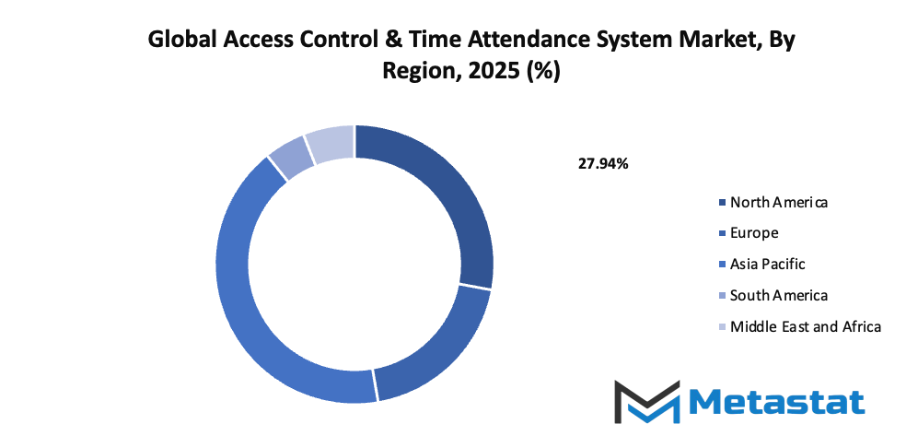
Growth Drivers
- Growing need for enhanced security and data protection in organizations: Organizations will prioritize the protection of physical and digital assets to prevent breaches and ensure compliance with regulations. Enhanced security measures will include controlled access, surveillance integration, and real-time monitoring. As cyber and physical threats grow, adoption of advanced access control solutions will become critical to maintain operational safety and integrity.
- Rising demand for workforce productivity monitoring and automation: Companies will focus on improving efficiency by tracking attendance and employee activity accurately. Automated time attendance solutions will reduce manual errors, save administrative time, and allow better resource management. Organizations will use data-driven insights to optimize workforce productivity while ensuring accountability across various operational units.
Challenges and Opportunities
- High installation and maintenance costs: Implementing advanced access control systems requires considerable financial resources. Costs include hardware, software, network integration, and periodic maintenance. Organizations may face budget limitations that slow adoption. Over time, efforts to reduce these costs through scalable solutions and vendor support will encourage wider deployment of access control systems.
- Concerns over data privacy and system vulnerabilities: The global access control & time attendance system market must address risks related to data breaches, unauthorized access, and cybersecurity threats. Organizations will focus on secure storage, encryption, and regular updates to prevent vulnerabilities. Addressing privacy concerns is essential for gaining user trust and ensuring regulatory compliance.
Opportunities
- Integration of biometric and AI-based technologies for advanced authentication and analytics: Biometric systems combined with artificial intelligence will transform how organizations authenticate users and analyze attendance patterns. Facial recognition, fingerprint scanning, and AI-driven monitoring will provide high accuracy and real-time decision-making. Such advanced integration will enhance security, streamline operations, and support futuristic workplace management strategies.
Competitive Landscape & Strategic Insights
The global access control & time attendance system market will continue to grow as technology advances and security demands increase. The industry is a mix of both international industry leaders and emerging regional competitors, which ensures that innovation and competition remain high. Important competitors include Acre Security, ANVIZ, Interflex, Telegroup, dormakaba Holding AG, Allegion plc, Hikvision, IDEMIA, Salto Systems, S.L., Dahua, Suprema Inc., Realand, FingerTec, ASSA ABLOY AB, BioMax, eSSL, and ZKTeco. These companies will drive improvements in system efficiency, reliability, and integration capabilities.
In the future, the global access control & time attendance system market will likely see more intelligent systems capable of combining access control with real-time data analytics. Systems will not only track entry and exit but will also help organizations optimize workforce management and enhance safety protocols. Advanced biometric technologies such as facial recognition, fingerprint scanning, and iris scanning will become more accurate, faster, and widely adopted, increasing both security and convenience.
Regional competitors will play a significant role in expanding the global access control & time attendance system market, especially in areas where international brands face challenges due to cost or local preferences. These emerging players will focus on creating affordable, user-friendly, and adaptable solutions tailored to small and medium-sized enterprises, while global leaders will continue to innovate with high-end solutions for large corporations and government projects.
Integration with other smart technologies will be a major trend. Access Control & Time Attendance systems will connect with IoT devices, cloud platforms, and artificial intelligence tools to provide seamless management and predictive insights. Security will no longer be limited to doors or gates; the systems will monitor environments, detect anomalies, and respond to potential threats automatically.
The global access control & time attendance system market will also experience changes in regulations and standards, which will guide system development and adoption. Companies that can anticipate these changes and offer flexible, compliant solutions will gain an advantage. As organizations increasingly rely on digital solutions for security and workforce management, the demand for sophisticated, reliable, and scalable Access Control & Time Attendance systems will continue to rise.
Market size is forecast to rise from USD 3906.8 million in 2025 to over USD 7911.8 million by 2032. Access Control & Time Attendance System will maintain dominance but face growing competition from emerging formats.
In conclusion, the global access control & time attendance system market will be shaped by a balance between established global leaders and emerging regional competitors. Innovation, integration with smart technologies, and the ability to respond to evolving security needs will define success. Companies such as Acre Security, ANVIZ, Interflex, Telegroup, dormakaba Holding AG, Allegion plc, Hikvision, IDEMIA, Salto Systems, S.L., Dahua, Suprema Inc., Realand, FingerTec, ASSA ABLOY AB, BioMax, eSSL, and ZKTeco will play pivotal roles in driving the future of this industry, creating solutions that are smarter, faster, and more efficient.
Report Coverage
This research report categorizes the global access control & time attendance system market based on various segments and regions, forecasts revenue growth, and analyzes trends in each submarket. The report analyses the key growth drivers, opportunities, and challenges influencing the global access control & time attendance system market. Recent market developments and competitive strategies such as expansion, type launch, development, partnership, merger, and acquisition have been included to draw the competitive landscape in the market. The report strategically identifies and profiles the key market players and analyses their core competencies in each sub-segment of the global access control & time attendance system market.
Access Control & Time Attendance System Market Key Segments:
By Type
- Card Type
- Password Type
- Biometric Type
By Application
- Government Agencies
- Factory
- Office Building
- Other
Key Global Access Control & Time Attendance System Industry Players
- Acre Security
- ANVIZ
- Interflex
- Telegroup
- dormakaba Holding AG
- Allegion plc
- Hikvision
- IDEMIA
- Salto Systems, S.L.
- Dahua
- Suprema Inc.
- Realand
- FingerTec
- ASSA ABLOY AB
- BioMax
- eSSL
- ZKTeco
WHAT REPORT PROVIDES
- Full in-depth analysis of the parent Industry
- Important changes in market and its dynamics
- Segmentation details of the market
- Former, on-going, and projected market analysis in terms of volume and value
- Assessment of niche industry developments
- Market share analysis
- Key strategies of major players
- Emerging segments and regional growth potential



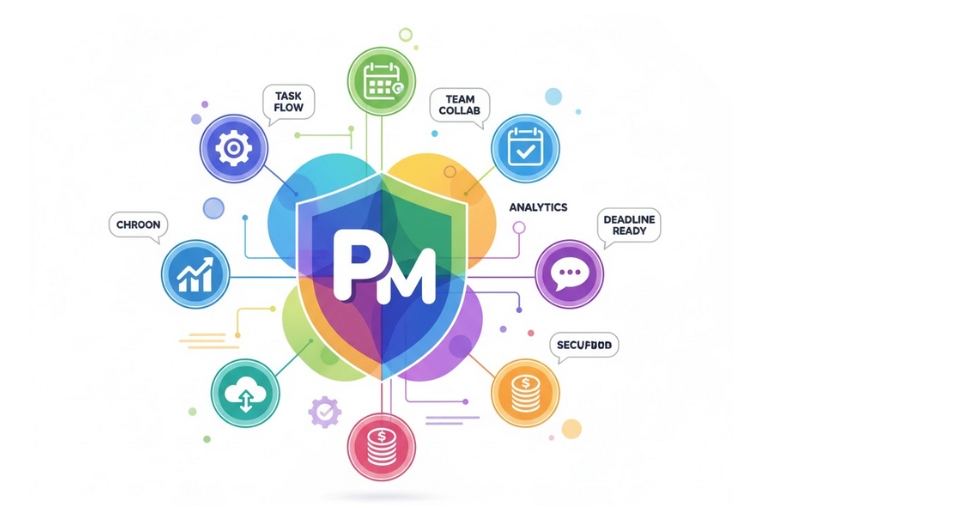
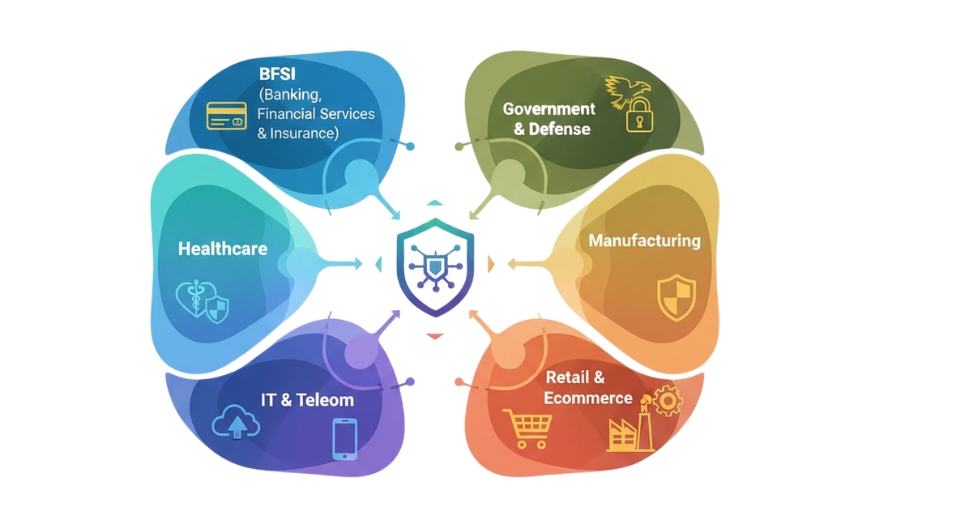

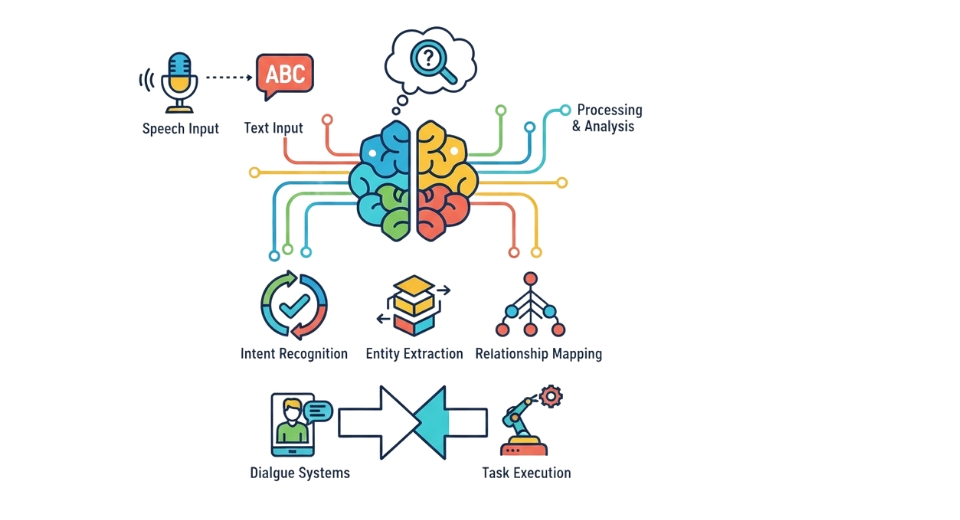

 US: +1 3023308252
US: +1 3023308252






